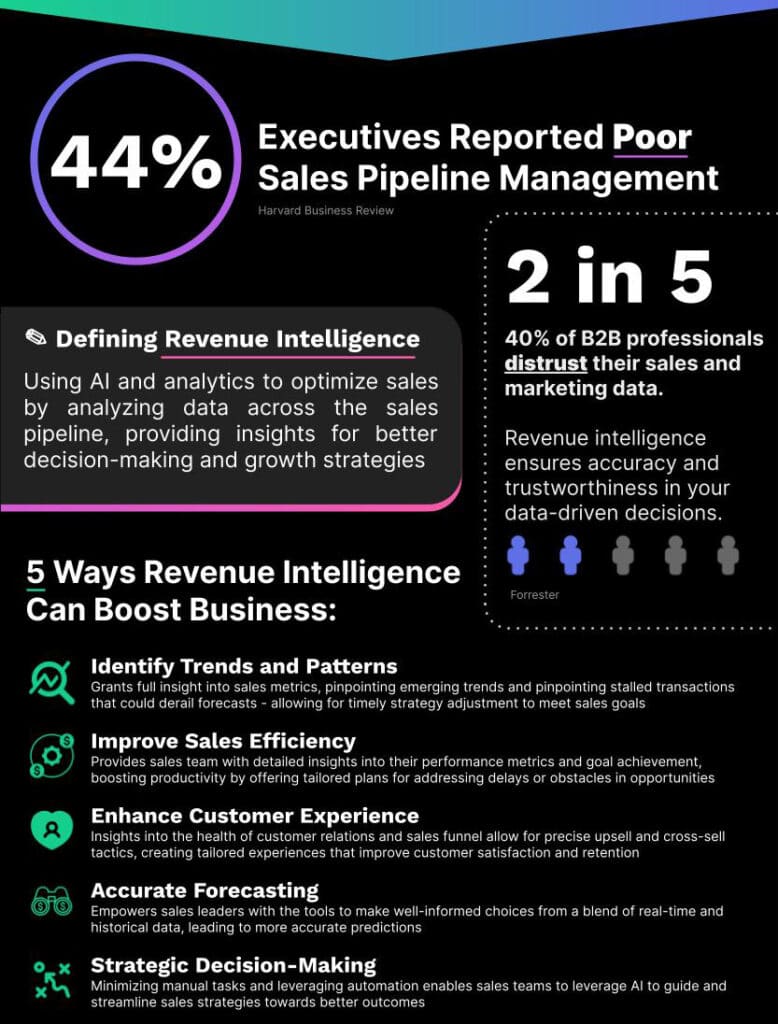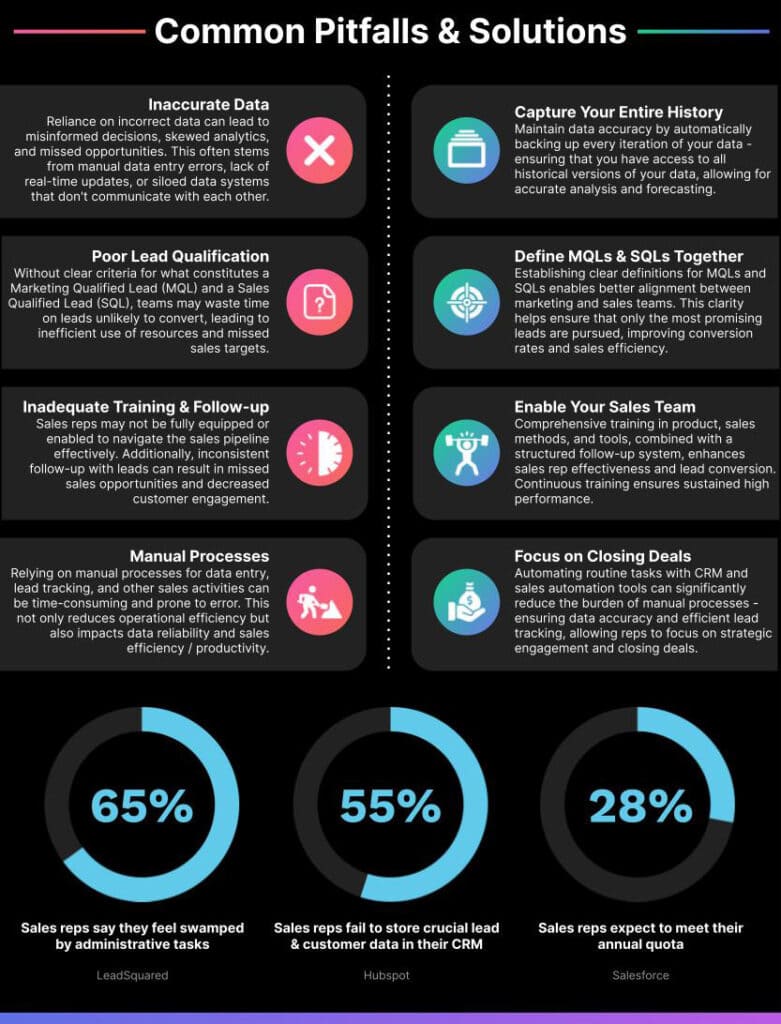Ensure Accurate Pipeline Data with GRAX

Would it surprise you to learn that 44% of executives say their organization does a poor job of managing their sales pipeline? Or that only 28% of sales reps expect to meet their annual quota? What about the fact that 40% of B2B pros don’t trust the data they use for sales and marketing analyses?
These alarming stats should be a wake-up call for all sales leaders. To ensure your company doesn’t experience problems like these, use data-driven revenue intelligence to boost sales performance.
What is revenue intelligence?
Revenue intelligence refers to the strategic use of AI and data analytics to understand your sales process. It tells you which deals are hot, which are not, where they’re stuck, and how to move them forward faster.
The practice of revenue intelligence involves collecting, analyzing, and interpreting data from various sources. These include sales activities, prospect, and customer interactions as found in your Salesforce CRM, market trends, and competitive intelligence.
5 ways revenue intelligence accelerates business
- Identify trends and patterns: Analyze sales data and market trends to identify opportunities for growth and areas needing improvement.
- Improve sales efficiency: Empower sales team to focus on the most promising, high-value and opportunities so they can improve conversion rates and pipeline velocity.
- Enhance customer experience: Tailor sales approaches and interactions to customer and prospect behavior, improving close win rates.
- Accurate forecasting: Data-driven foundation for more precise sales and revenue forecasting, removes surprises and helps companies plan more effectively.
- Strategic decision-making: Holistic view of your revenue-generating process helps to better align sales strategies with business goals.

Sales pipeline management: the heart of revenue intelligence
A sales pipeline is your roadmap from initial contact to closing a deal. Theses sales funnels / pipelines typically include these stages:
- Lead generation
- Lead qualification
- Proposal
- Negotiation
- Closing
- Post-Sale
Each stage of the pipeline is a checkpoint that gets you closer to the finish line. But not all sales funnels are created equal. Without a clear strategy for managing each stage and for moving prospects / potential customers from one stage to another, deals can stall or fall through the cracks.
Ready to revolutionize your sales strategy?
Learn more about harnessing the power of your data by connecting Salesforce to Google Sheets—a game-changing step. Dive into our comprehensive guide now and supercharge your sales pipeline today!
5 sales pipeline pitfalls to avoid
- Using inaccurate data
Historical data is the backbone of effective sales pipeline analysis and Salesforce analytics. It enables Salesforce users to identify patterns, assess performance against past results, and refine strategies for improved outcomes. Without accurate historical data, forecasting becomes guesswork, and the potential for strategic missteps increases.
However, many companies inadvertently use inaccurate data to populate their pipelines and drive their analyses and forecasts. For instance, they may go into Salesforce to pull data from the previous 3 months not knowing that someone mistakenly changed the historical data in their most recent snapshot of their production environment.
The best way to ensure this doesn’t happen is to use a tool such as GRAX that backs up and replicates every version of Salesforce data into your own cloud. This ensures you always have a complete and accurate snapshot in time, and that you’re using the highest-quality data for analyzing your sales pipeline. With GRAX, you can even easily access archived data to analyze trends over longer periods of time. - Poor lead qualification
This is a common issue for sales teams. Make sure you define and agree on what constitutes an MQL (marketing-qualified lead) and an SQL (sales-qualified lead) for your business. If you don’t, sales teams may waste time on leads that should never reach their desk – instead of spending time on ones with higher conversion potential. - Inadequate training
Don’t assume your sales representatives know how to manage the pipeline effectively. Conduct regular training on what each stage entails and the steps involved in progressing a lead through the pipeline. It’s also important to train them on using Salesforce to track the right information – and tell them to use it consistently. - Inconsistent follow-up
Consistent follow-up is key to advancing prospects through the pipeline. Many companies fail at this due to a lack of standardized processes or because sales reps are overwhelmed with tasks and poorly qualified leads. In fact, 65% of sales reps say they feel swamped by administrative tasks. Maybe that’s why they spend only 28% of their time actually selling. According to one study, 80% of sales require an average of five follow-ups in order to close the deal. However, 44% of sales reps follow up with a prospect only once before giving up. 94% give up after four times. All this points to conversion potential.
To help improve your team’s engagement success, consider using Salesforce Sales Engagement. It’s designed to streamline and enhance the sales process, particularly for inside sales teams. Built on the Salesforce platform, it integrates with Salesforce Sales Cloud to automate routine tasks, guide sales reps through best practices, and offer insights and analytics to optimize sales activities. - Reliance on manual processes
In today’s digital age, relying on manual processes for managing a sales pipeline is inefficient and prone to error. Manual data entry and tracking can lead to inaccuracies and overlooked opportunities. Instead, use Salesforce to track data and access reports. You can even use Google Sheets to easily visualize your pipeline based on historical Salesforce data.

7 sales pipeline metrics to track
Tracking the right sales metrics is essential for any sales team aiming to boost performance, refine strategies, and achieve their goals. These are the metrics you should track:
- Opportunities
Opportunities provide a clearer picture of potential future revenue. Tracking the number, size, and quality of opportunities in the pipeline helps sales leaders make more accurate forecasts about sales performance and revenue generation. Understanding which opportunities are converting—and why—enables you to refine your sales process. - Conversion rate
The conversion rate measures the percentage of prospects that turn into actual sales. It’s a key indicator of how effective your sales team is at closing deals and how appealing your product or service is to your target market. A decline might indicate a need for better sales training or a reassessment of your messaging or target market. - Average deal size
This tells you the average revenue generated per sale. It helps in forecasting revenue and understanding the types of deals your team is most successful in closing. It can also signal when it’s time to push for higher-value deals. - Sales cycle length
This measures the average time it takes to close a deal from the first contact. If your average sales cycle length is 60 days but competitors are closing similar deals in 45, you may have a problem. To decrease the time to close you may need to evaluate your lead qualification methodology or investigate which stage in the funnel your deals are getting stuck so that you can streamline your sales process. - Close win rate
This calculates the percentage of deals in the final stage of the sales pipeline that you win. It’s a direct indicator of your sales team’s effectiveness at sealing the deal. A high close win rate suggests your sales strategies, pricing, and product-market fit are aligned well with customer needs. Monitoring this metric over time can help identify trends, strengths, and areas for improving win probability. If this rate starts to decline, it might signal issues with pricing, competition, or a sales pitch. - Customer lifetime value (CLV)
CLV predicts the total value a customer will bring to your company over the entire duration of the relationship. Understanding this helps in making informed decisions about customer acquisition costs and prioritizing customer retention efforts in order to increase lifetime value. - Sales pipeline velocity
Tracking sales pipeline velocity is crucial for understanding how quickly deals are moving from initial contact to closed sale. It’s a comprehensive metric that combines several key factors of sales performance into one indicator.
The formula looks like this:

Benefits of tracking sales pipeline velocity
- Improves forecasting accuracy
Gives you a dynamic view of how fast you’re turning prospects into revenue. This is essential for planning and resource allocation and predicting expected revenue. - Identifies bottlenecks
Pinpoint stages in your sales process where deals are slowing down. This is invaluable for streamlining your sales process and removing obstacles that could be hindering your team’s performance. - Enhances sales strategy
Understanding how different variables affect your pipeline velocity (e.g., deal size, win rate, sales cycle length) can inform strategic decisions. For instance, you might find that focusing on a particular market segment increases your average deal size or win rate, positively impacting your overall velocity. - Drives revenue growth
Ultimately, increasing your pipeline velocity can directly lead to revenue growth. By moving deals through the pipeline more quickly and efficiently, you could close more within the same time frame.
Revenue intelligence is not just another tool in your sales arsenal. It’s a fundamental shift in how you approach your pipeline. By leveraging the power of historical data and focusing on the metrics that matter, you gain the insights you need to make informed decisions and accelerate your sales pipeline. Leave the guesswork behind and start using revenue intelligence to power your sales success.
Maximize Sales Performance
See how you can amplify results easily with GRAX.






